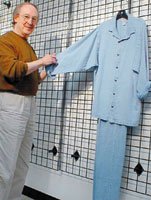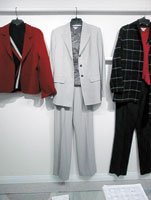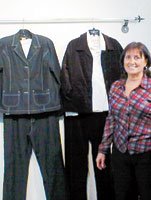Canadian Resources Mount U.S. Growth
There’s something about Canada, local retailers and reps are saying, and that something is missy apparel, which has become hard to find at the right quality and price point domestically. Thanks to the North American Free Trade Agreement (NAFTA), Canadian resources are growing their businesses powerfully by exporting to the United States.
NAFTA began as a trade agreement between the United States and Canada in 1989 and blossomed into a pact in 1994, removing or reducing tariffs between the three North American nations (the two aforementioned nations and Mexico).
Fred Postal, owner of Fred Postal Associates, currently reps Canadian resources nearly exclusively in both his California and Dallas showrooms, but in the past he carried both Canadian and domestic labels. As Postal’s business with his Canadian lines Ezze Wear, Go Nutz and Fitz grew, he began dropping his domestic labels from his showroom mix.
“Over the last several years, after NAFTA lowered the border, there has been an explosion,” said Postal. “Canadians are known for their quality merchandise and price points. Those resources represent a good value because of the dollar difference.”
Brian Litvin, owner of Toronto-based Go Nutz, credits a 500 percent rise in his company’s business to NAFTA, acknowledging that he previously hadn’t been doing much business in Canada.
“NAFTA is a major contributor to our success,” said Litvin. “We are now able to compete to a degree with the third world countries, and our strength is that we can do small runs with a quick turnaround time, which is attractive to the American [retail] customer.”
Loretta Kendrick, who reps Montreal-based denim line French Dressing in the California Market Center (CMC), concurs, reporting that her Canadian imports perform as well as her best local resources. Kendrick took the brand from 30 retail accounts to more than 150 in less than two years.
“Generally, California resources respond quickly and Canadian resources do, too,” said Kendrick. “Canadian resources are also a bit more in tune with [missy] trends.”
Kendrick lists styling and fit as other reasons Canadian resources perform so well.
“They understand the true missy, but they also have a slimmer, natural fit and a more relaxed fit for heavier thighs and hips,” said Kendrick. “Once someone tries on French Dressing, they are sold, and once they are sold, they stay with you.”
Such resources as Toronto-based Ezze Wear have also paid close attention to maintaining customers. Natasha Brunklaus, national sales manager for the line, reports minimum 20 percent annual growth over the past two years doing business in the United States.
“The growth is in repeat business,” she said. “It’s nice to have new business, but once you get the customer, you want to keep them. The best part of our market is the repeat business.”
Yet another reason for the success of Canadian resources is pricing. Kendrick said that her showroom was carrying missy tops and “had been looking for a denim line for years,” adding, “Aside from Calvin Klein, Donna Karan or Liz Claiborne, it’s hard to find a good missy resource.” French Dressing provided the perfect complement.
While some reps list pricing as key, still others report that the high quality of Canadian resources is what keeps customers coming back.
Amy and Jeff Belluck have been repping Joseph Ribkoff for 13 years. “Three to four years after Ribkoff came in, more [retail] people came in,” said Belluck. “They have a high quality of garment reflected in their not cutting corners to satisfy prices.”
Betty Ann Vater, director of international sales for French Dressing, which began doing business in the United States in the mid-1990s, said that her company decided to venture outside of Canada for growth reasons.
“I find Americans really respond well to good product and good service,” she said. “But I really don’t think that NAFTA has had a huge impact on either side of the border. I don’t think anybody is buying or not buying because of NAFTA.”
Vater said she believes the line is doing extremely well in the United States because of heavy marketing. Promotions are launched for Mother’s Day, and during Breast Cancer Month, which is October, French Dressing donates $1 to breast cancer research for every customer that tries on the jeans.
Vater also noted that NAFTA has not removed the duty on fabric not made in the United States, which continues to make it tough for some Canadian manufacturers.
“We still pay a tremendous exchange on the dollar and nothing will change that,” she said.
However, Brunklaus reported that Ezze Wear dealt with the problem by looking for fabric outside of Canada.
“There are a lot of rules and regulations, especially with textiles,” said Brunklaus. “But we’ve been resourcing the U.S. and Mexico for fabric for our line.”
Of course, when all is said and done, the success of Canadian resources is due to their strong performance in specialty stores.
Toni Gartner, owner of Balisimo in Redondo Beach, Calif., who has been carrying several Canadian lines since 1994, including Jax, O Susanah and Nygard, said that while NAFTA has called more people’s attention to Canada, some people have always known about its apparel offerings. Gartner said she prefers Canadian lines, because “Canadians and Europeans have better style.”
“The Canadians have always had good lines,” she said. “The more they show here, the more people realize it.”
Sunny Meyerson, who reps the higher-end Jax in the CMC, said that the true advantage Canadian lines have over U.S. lines is that they can manufacture their own garments without the heavy overhead from wages.
“Most American specialty lines are made in China,” she said. “The minimum wage [in the United States] is so high, very few manufacturers can afford to make their garments here. We also don’t have machines in this country that can do the embroidery.”
Meyerson added that Canadians are still passing down a sewing tradition that Americans have “all but abandoned.”
According to Georgia Rosenblat, owner of Iris in Palm Desert, Calif., Ezze Wear is her best-performing line.
“Because we are in the desert, we need more lightweight fabrics in a variety of colors, and Ezze Wear makes a type of cord for the fall that is still lightweight yet thicker for the cooler nights,” she said. “The combination of lightweight fabrics and a huge variety of colors makes it an easy seller. I can’t think of a domestic line that sells as good.”
Go Nutz’s Litvin reported that his company targets specialty retailers as well after conducting research on American tastes and practices before coming into the country.
“We had to investigate the American customer to find out what the American lady wants,” said Litvin. “I find that there is a lot more color appreciation, and a lot more art appreciation. The American customer also looks for a more comfortable fit.”
Rep Postal, who conducted his own research into the Canadian apparel business before jumping in to rep Canadian resources primarily, said he also believes that the study and adaptation of U.S. trends and business practices is key to the success of Canadian resources here.
“For years, the Canadians have prepared two major collections per year, training the Canadian buyer to buy twice a year and program their deliveries on certain groups,” said Postal. “The U.S. market is a four-market-per-year business and now the Canadians are adapting to the U.S. way of business.”
Postal continued: “Montreal mimics Paris or New York, with an understated elegance and sophistication. Toronto, which is the financial center of Canada, has more of a mix of playwear, but is still sophisticated, and once you get to the western region, they are very hip and more aggressive in their approach to fashion. If you look at the West Coast of the U.S. and the West Coast of Canada, like products do well. On the East coasts, there are differences, primarily because of climactic changes.”
According to Postal, there is no better time than the present for retailers and reps to take advantage of the Canadian explosion.
“Canadian resources are doing so well that whatever comes out of Canada, the buyers want to see,” said Postal. “Canada is a magic word at retail right now.”
























